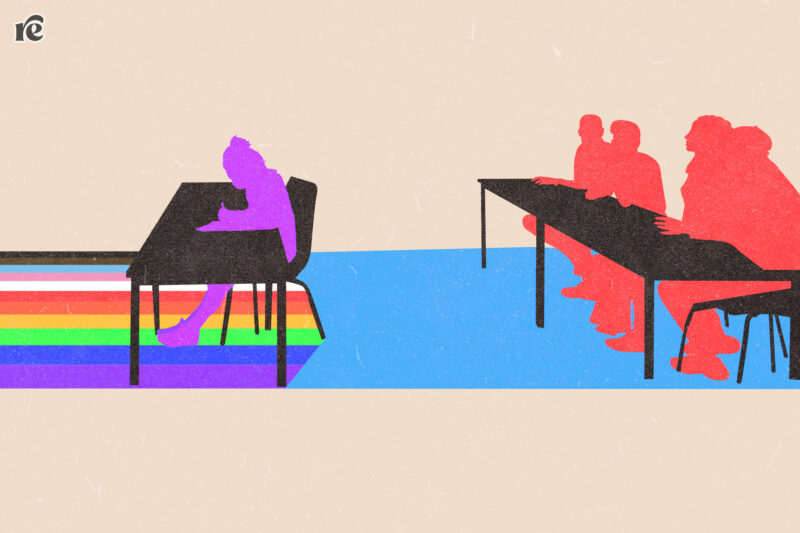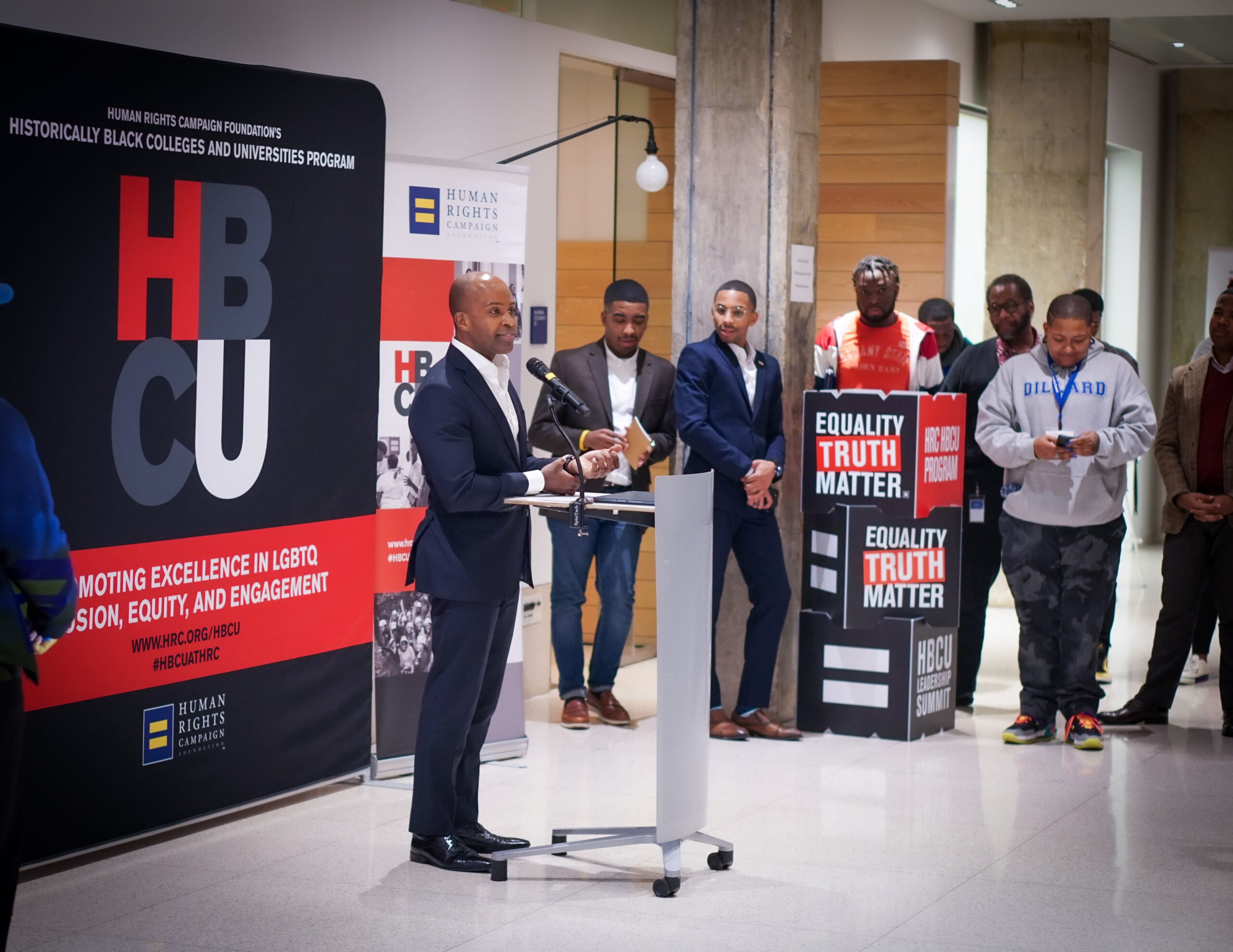HBCUs Are a Safe Haven—But LGBTQ+ Students Don’t Feel Like They Have a Space On Campus
"I think my expression of being queer really affects how I am perceived by others on campus.”

This story is part of our back to school issue. Check out the rest of our Campus Dispatch stories here.
When Rykki Lide arrived at North Carolina A&T State University, a historically Black university, in 2022, the campus culture was not what they expected.
“You know, when you come to these institutions and do the research on them, you expect them to be this safe space for all Black people,” Lide said. “But when you get there, the culture is not here. It is very cliquey and standoffish. I think my expression of being queer really affects how I am perceived by others on campus.”
Lide’s experience at NCAT wasn’t unique: Devin Pryor, a recent Florida A&M University graduate, told Rewire News Group that as a queer student, he didn’t feel like he could fully be part of the student community.
“Being queer on campus isn’t frowned upon per se, but it makes it pretty difficult to go for more prestigious roles on campus, such as Mr. FAMU, or join Divine Nine organizations,” Pryor said. “We kind of have these stigmatizations that we cannot be part of the community to access those kinds of opportunities.”
Historically Black colleges and universities (HBCUs) have long been a haven for many of their students. Their campuses provide an outlet for Black students to express themselves freely without judgment and allow them to be in an environment with peers of similar ethnic backgrounds.
Although HBCUs are safe for some, that’s not the case for others. LGBTQ+ students at HBCUs often go unnoticed and ignored, with little to no protections provided to support them. They also lack many queer resources, such as LGBTQ+ medical services, a strong Pride student union, or an LGBTQ+ resource center.
Institutions’ histories influence current student culture

Many HBCUs’ lack of queer resources can partially be traced back to the history surrounding their founding—which has often been intertwined with religion, as Black churches and missionaries founded many of these universities. Between 1866 and 1882, the United Methodist Church established 70 schools—11 of which still operate—for Black people, including Claflin University in South Carolina and Clark Atlanta University. Other major HBCUs were founded by churches: Atlanta’s Morehouse College was founded by Springfield Baptist Church in 1867, and Ashbury Methodist Episcopal Church founded Mississippi’s Rust College in 1866.
Because of these religious influences, a lot of the schools’ curricula taught anti-LGBTQ+ ideas. It has also created a culture of conservatism at HBCUs, which has led to the suppression of identities that are not heteronormative. The effect of those values can still be felt today, which contributes to the reason why many HBCUs lack the support their LGBTQ+ students need.
According to a recent study, LGBTQ+ students at HBCUs experience conflict with a religion-backed binary gender system and an evolution of student identity and expression. This culture continues to suppress LGBTQ+ students who attend these institutions.
The lack of resources and support from HBCUs can change the environment for queer students at these institutions. They are often left feeling excluded and lacking community, which can lead them to other outlets to find safe spaces. Queer students may also feel pressure to suppress their identities from the lack of representation from their universities.
Some HBCUs do have resources for students, but they are not functioning properly or not well maintained, preventing students from benefiting from them and getting the support they need.
This reflects Georgette Walley’s experience as a marketing student at Savannah State University.
“On the student side of things, I feel represented but not so much from the administration side,” Walley said. “I feel like SSU does things to suppress the presence of queer people on campus. Although we do have a rainbow room, which is supposed to be a safe space for queer students, it was recently found in a very disgusting state and not maintained like the other student rooms.”
Lide recounted similar experiences with NCAT’s ill-maintained resources, which they say has affected their environment at school.
“The administration’s support of queer students is also lacking,” Lide said. “We have a department, but they don’t do a good job of supporting the queer population. There are so many ways that they can improve.”
Charting their own path
Despite the adversity queer students face at their institutions, they are putting in the work to find and create community on their campuses. Many are making a path for themselves while being unapologetically queer in a heteronormative space.
Students at these HBCUs have created their own safe spaces, such as MOSAIC, made by queer+ Hampton University students in 2017, and Florida A&M Spectrum, the school’s Pride union, which was re-founded in 2022 after ceasing operations because of COVID-19.
“You know, when you come to these institutions and do the research on them, you expect them to be this safe space for all Black people, but when you get there, the culture is not here.”
– Rykki Lide, North Carolina A&T State University student
For some students, it can be easier to find other queer students to be in community with, while others have more difficulty and feel isolated. Evan Stevenson, a Florida A&M senior, said they’ve had their fair share of both feelings.
“The queer community here is very welcoming and friendly, but I feel like it’s a lot easier to find the queer people but not the queer spaces,” Stevenson said. “There are definitely some times where I feel surrounded by the queer community, but there is some lack too.”
Progressing institutional LGBTQ+ inclusion
Despite the lack of adequate resources for queer students, progress has been made to improve their experiences. Bowie State University in Maryland is the first HBCU to establish an LGBTQ+ resource center, providing information and training to support queer students and champion inclusion on campus.
Howard University offers gender-inclusive housing that is “affirming and supportive of transgender, gender nonconforming, and ally students,” according to the student affairs website. The institution’s LGBTQ+ resource center that aims to support queer students and build an inclusive community.
Spelman College, a historically Black women’s college, started on the road to progress in 2017 by allowing transgender women to be admitted. Morehouse, a historically Black men’s college, followed suit two years later to allow transgender men to be admitted.
But there is plenty of room for improvement. According to Campus Pride, a volunteer nonprofit group that advocates for safe college environments for queer students, five out of the approximately 107 HBCUs have an active LGBTQ+ resource center, and at least 24 have an active LGBTQ+ organization or safe space.
A need for change is felt by many, including Pryor, who hopes that Florida A&M University can better its space to be safer for queer students.
“I think that there are some things that are here for us, but FAMU can do a better job of highlighting all groups that are on campus,” Pryor said. “They provide a space for the queer community on campus, but it is not safe enough for us to fully be ourselves. We need to be able to feel comfortable here and be fully accepted by everyone.”
